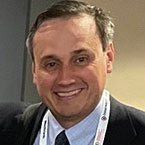By: Diya Kallam, BA & Brian K. Reilly, MD, FACS, FAAP
Single-sided deafness (SSD) is a hearing loss that affects at least
one in every 1,000 babies born. These infants have severe-to-profound hearing loss in one ear with typical or near-typical hearing in the other ear. The condition can also develop in older children and adults.
If your child shows symptoms of SSD, sometimes called unilateral hearing loss, talk with their doctor right away. Early identification of children who are deaf or hard of hearing (D/HH) is critical to language development.
Symptoms of single-sided deafness to know
Tinnitus (ringing) in one ear
Selective use of phone in only the hearing ear
Head turning to hear the source of a sound
Difficulty hearing in noisy environments
Auditory fatigue from the extra effort that listening requires
Early diagnosis and treatment for hearing loss is key
How is single-sided deafness diagnosed?
If any symptoms of SSD are identified, your child's pediatrician may refer your family to a pediatric audiologist who will perform the appropriate diagnostic and intervention services. A pediatric audiologist may perform a type of hearing test called a behavioral audiogram.
For infants, the audiologist will perform an auditory brainstem response test. This hearing test involves tonal sounds and clicks that are played. Electrodes measure your child's response to these noises by tracking brainwaves.
Treatment for single-sided deafness
Once diagnosed, there are several treatment options for SSD. Treatment may include steroids, varied seating in the classroom, hearing aids, or bone conduction hearing devices. The most successful treatment for SSD is cochlear implantation.
What is a cochlear implant?
A cochlear implant is an electronic device that sends signals to the cochlea (inner ear). These signals are perceived as sound and coded into speech.
How does a cochlear implant work?
A
cochlear implant consists of four parts: a microphone, sound processor, transmitter and electrode array. The microphone picks up sounds which are converted by the sound processor. The transmitter then sends the sounds into electrical impulses through an electrode array, which takes the impulses to the auditory nerve.
For patients with SSD, the cochlear implant is placed surgically under the scalp and behind one ear. Cochlear implants have been shown to improve hearing over time and offer a better quality of life for children with SSD.
How can a cochlear implant help your child?
Some of the major benefits that cochlear implants can offer children with SSD include:
Sound localization, or the ability to identify the origin of a sound.
One study found that error in figuring out where a sound was coming from was decreased by 34% after receiving a cochlear implant. There was also less head turning among patients.
Speech discrimination, which is the ability to hear speech in quiet and noisy environments. has also been tested. Signals were played in noisy environments and patients with the cochlear implant were observed to see if they could pick out the sound. There was a significant improvement seen after patients underwent implantation.
Tinnitus reduction can be a major benefit for children with SSD, helping them to more easily concentrate.
One study found that tinnitus was completely suppressed in 43% of post-implant patients and that 38% of patients had a major improvement.
Binaural (two ear) input of sound to the brain can help with skills like localization and speech discrimination. Cochlear implants allow for binaural input, which can increase listening attention span.
What are the risks of cochlear implantation?
While cochlear implantation is generally a safe procedure, there are rare complications associated with it.
Meningitis: The pneumococcal vaccine should be given to kids who receive cochlear implants. Meningitis in children with cochlear implants usually develops due to the
Streptococcus pneumoniae bacteria. Even without the vaccine, though, the likelihood of developing meningitis is still rare (around 0.3%).
Facial nerve weakness: Facial nerve weakness or paralysis is very uncommon, with rates as low
as 0.71%. All patients who develop facial nerve weakness or paralysis should be prescribed steroids to potentially regain full facial function.
Dizziness: Some patients developed
dizziness or even vertigo post-implant, but
most cases resolved within a month.
Although there are risks to cochlear implantation surgery, complications are rare and almost all patients recover quickly from them.
Alternate treatments for single-sided deafness
A cochlear implant is the only device to offer binaural input, allow for sound localization and reduce tinnitus. The localization error for CI patients is much lower than patients with other devices.
Contralateral routing of sound devices (CROS),
osseointegrated implants (OI) and
bone anchored hearing aids (BAHA) can also be used to treat SSD. These technologies can improve speech discrimination, although
research shows that these devices are not as successful as cochlear implants. Patients are not able to overcome localization challenges and tinnitus as they can with cochlear implants.
CROS and OI may be considered for patients with congenital SSD.
Research suggests that for children with congenital SSD, the benefits of cochlear implants may not be as apparent as they are in children with acquired SSD.
Who can get a cochlear implant?
Cochlear implants are recommended for children living with single-sided deafness as young as 9 months old. Earlier implantation typically results in better speech and language outcomes. Young children who receive cochlear implants typically show improvement in sound discrimination, speech development and sound localization.
Remember
Talk with your child's doctor if you have any concerns about their hearing.
More information
About Dr. Reilly
 Brian K. Reilly, MD, FACS, FAAP, is a pediatric otolaryngolist and a member of the American Academy of Pediatrics Section on Otolaryngology – Head and Neck Surgery. He is Co-Director of Cochlear Implant Team at Children's National Hospital. Brian K. Reilly, MD, FACS, FAAP, is a pediatric otolaryngolist and a member of the American Academy of Pediatrics Section on Otolaryngology – Head and Neck Surgery. He is Co-Director of Cochlear Implant Team at Children's National Hospital.
|
About Ms. Kallam
 Diya Kallam, BA, is a medical student at George Washington University of Medical and Health Sciences. Diya Kallam, BA, is a medical student at George Washington University of Medical and Health Sciences.
|